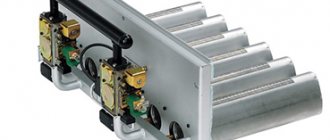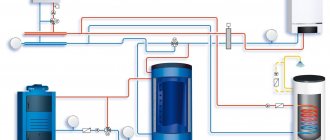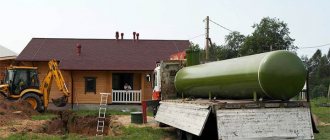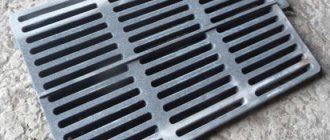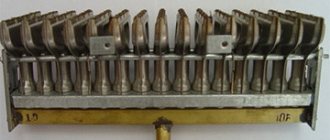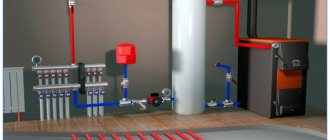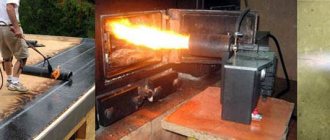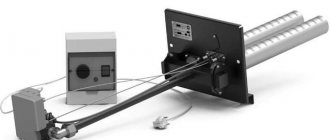A gas nozzle is a godsend for heating a private home. This device has a number of advantages: simple design of the spray device, safety in operation and high efficiency, and therefore its use becomes economically feasible. A gas nozzle for a heating furnace is a device with the help of which a gas-air combustible mixture is created in order to ensure complete combustion of fuel in the combustion chamber. Fuel injectors have a wide range of applications in thermal power engineering. They are installed not only in household stoves, but also in heating boilers of low, medium and high power, operating on gaseous and liquid fuels.
Combustion process in a boiler
The chemical reaction inside the boiler is a combustion reaction between oxygen (O2) in the air and hydrocarbons (CHyOx) in the fuel, which release energy as heat. During the combustion process, water vapor (H2O) and carbon dioxide (CO2) are formed, the latter being especially dangerous in terms of air pollution and global warming.
Other combustion products of injector gas may also appear depending on the type of fuel and combustion conditions: oxides of nitrogen (NOx) or sulfur (SOx), which are responsible for acid rain. Carbon monoxide (CO), a dangerous toxic substance, can cause death if inhaled.
Correct adjustment of the device reduces the amount of harmful combustion products. CO2 emissions are reduced when the gas is completely burned. In order to reduce NOx emissions, it is recommended to use the correct combustion technology, which is ensured by the design of the burner device.
Type of fuel used
Everything is much simpler here - the device can run only on gas or use several types of fuel. The first option is the simplest type of gas injectors and is the most popular in comparison with its “competitor”. As a rule, such products are installed in houses or apartments where there is a gas supply.
The second option has a more complex design, but can work with several types of fuel:
- liquefied gas;
- natural gas;
- diesel fuel.
Of course, the cost of such varieties is higher. Therefore, they are more often purchased in cases where gasification of the house is planned in the near future.
Space heating devices
They mix fuel and oxygen and, with the help of an ignition device, ensure complete combustion, which occurs in the combustion chamber, and the heat is transferred to water through a heat exchanger. Control devices regulate ignition, combustion speed, fuel and air supply, exhaust draft, water temperature, steam and water pressure in the boiler.
The hot water produced by the boiler moves through natural circulation through the in-house heating system of the entire building. The heating circuit may include hot water heat exchangers, air conditioning and ventilation units.
Gas heating of a private house: autonomous, main, air
Rating: 118
The heating method, in which flammable gases serve as fuel, involves placing heating devices in the rooms that are heated. Today, the most famous type of heating in country and multi-storey buildings can be called gas heating.
In the design of this type of heating system, in addition to the main devices, there are also gas pipelines, they create the conditions for fuel transfer and heat transfer, automatic devices that are needed to reliably operate the gas, a device that ensures hermetically sealed passage.
Types of designs
There are few different classes of heating equipment that run on combustible gas. Some devices are installed in country houses, while other installations are most suitable for heating industrial premises.
Equipment for modern heating stoves consists of: boilers, batteries, infrared heaters. As a rule, the latter device is used in rooms that are large. Quasars are usually mounted on the ceiling.
The design of electromagnetic heating is a box with a reflector turned towards the bottom with a faience attachment made of thin slabs with holes at the bottom.
There is a gap between the box and the nozzle. This is where the fuel mixture comes in and heats the tiles to a high temperature. Then the gas begins to burn on the hot earthenware nozzle, which gives heat to the houses, thus warming them up. When using this method, there is almost no combustion waste in the heating system, because the remaining gas waste is removed by ventilation.
Heating system with gas stove
Gas boilers
When you want to design gas heating in a private home, the best alternative is a heating boiler. The choice of this heating system must be approached very carefully, because the comfort and warmth in the house depends on it. The most important property of equipment burning natural gas is its boiler power. They can be small (4-65 kW), not very large (up to 1700 kW) and maximum (up to 15000 kW) capacity.
The type of gas burner and appliance depends on the power of the gas appliance. Among other things, it is necessary to take into account that wall-mounted heating boilers are of low power, while those standing on the floor are, on the contrary, large. They also have differences in the structure of the structure and what material the heat exchanger is made of. Copper heat exchangers are mainly used on the wall, while heat exchangers made of cast iron or steel are installed on the floor.
Boilers used in gas heating are 1-circuit or 2-circuit.
Single-circuit boilers are installed to heat only the room. The heated water leaves the water heater. 2-circuit boilers are installed not only for heating, but also to provide hot water. With low hot water consumption, such devices are flow-through and have a built-in storage boiler. In it, a gas burner heats water, or a coil is connected to the boiler.
Appliances for burning natural fuels have several components:
- Gas-burner. This is a perforated quadrangular structure. The heating gas nozzle is located inside it.
- Heat exchanger. A radiator with coolant and pipes is built inside this casing.
- Circulating pump. With its help, pressure is generated in the line.
- Expansion tank. It is not needed for permanent storage of water when it expands when heated.
- Combustion waste collection device.
- Automation for operation of the entire heating system.
Gas boiler design
Wall-mounted air heater
The most well-known method used for liquefied gas heating is conventional gas cylinders. Besides the reasonable price, it also has many other advantages.
The first is ease of assembly. Standard fasteners are used here, so assembling the pipes is easy and you can do it yourself. But still, specialists must configure this equipment.
Today's gas convectors are small. Therefore, they go well with any decor in the house.
The main advantage of such a system is its safe operation. Because everything is controlled by the boiler automation. Among other things, convectors last a long time. Of course, this depends on the material from which they are made, usually around twenty to fifty years.
Gas convectors can operate from a gas pipe, or also separately if there is a gas cylinder. The number of these cylinders depends on the size of the room. They can stand not only in rooms, but also in specially equipped cabinets, they are placed near the external walls of the house. When such gas cylinders are used, heating becomes convenient and cheap.
Wall gas heater
Assembly of gas heating equipment
Installing gas heating appliances in a house requires several periods:
- First, a design of the entire system is made, then the necessary equipment is purchased, after which the entire system is assembled and filled with water.
- When both the project and the heating scheme are completed and signed by the gas service specialists, all equipment has been purchased, the time has come for installation of the entire system.
- All assembly is done by specialists. First of all, pipelines and heating risers are assembled, automation and control devices are fixed. After everything, gas heating is started and optimized.
Advantages of main heating
Among the obvious advantages of this heating are several:
- Low activity (instant access to the desired work mode, instant heating of the room);
- High efficiency (80-95%);
- There is no need to regularly provide a supply of fuel;
- Does not depend on electricity;
- Air conditioners, baths, area lighting, etc. operate from such heating;
- the work process is almost completely automated;
- these systems are commensurate with modern environmental standards because they produce very few harmful substances;
- no operating costs;
- you can change the temperature;
- The price of the equipment is very good.
Autonomous gas heating
If you do not want to cut into a common highway, or there is none on the site, then you need to make an autonomous gas heating system. Such a system uses heat economically, and there will be no losses in the main line.
It is good to make a plan for such heating when creating a house project. Because you need to immediately find where the boiler room and gas tank will be located. Fuel from it must be supplied to the premises underground using a gas pipeline.
In addition, such a boiler room not only performs a heating function, but also provides hot water and gas supply to the gas stove.
Autonomous system diagram
Gas heating via air
In most cases, it is used in industry, warehouses and entertainment systems.
They also began to provide such heating to country houses.
The principle of operation of the air heating mechanism is that air masses enter the heat exchanger and are supplied into the room with the help of a fan. These devices are different - they depend on the type of fan, coolant, power.
Along with air heating, gas guns are also used. They come not only with gas, but also in cylinders. All these guns create direct heat and have no combustion waste. They are mainly used for heating warehouses, greenhouses, and open areas.
Didn't get an answer to your question? Ask our expert: Ask
sdelatotoplenie.ru
Device classification
The industry produces a very large number of gas injectors of various types, purposes and designs, which are strictly classified by type of fuel and method of air supply. Air supply classification:
- Atmospheric burners are burners in which air is supplied naturally; it is captured in a Venturi tube by a gas stream using the principle of an injector.
- Forced air or pulse burners are equipped with a fan that provides air flow for combustion of the air-fuel mixture and removal of products resulting from fuel combustion.
The gas burner for the stove in the house is divided by type of fuel:
- Gas for burning gaseous fuel.
- Burner for burning liquid fuel.
Video description
Video demonstration of how a stove gas burner works:
- For boiler.
Industrially manufactured heating units are equipped with burners of a given power, and therefore the consumer does not have to make any adjustments. It’s another matter when the boiler has to be assembled from separately purchased components.
In this case, it is necessary to take into account the type of combustion chamber of the unit - closed or open. The type of gas burner suitable for the appropriate operating conditions will depend on this indicator. Power, serviced area, need for automation and other important factors are also taken into account.
- Universal models.
Removable burners designed for installation in any suitable equipment. For example, they can be equipped with boilers and furnaces operating on solid or liquid fuels. At the same time, for maximum efficiency and productivity, such installations are equipped with a powerful air supply system, filters, gearbox and automation.
Operating principle of an atmospheric burner
The gas, entering the nozzle nozzle, increases its speed and creates a vacuum at the base of the torch, which sucks in part of the combustion air, the so-called primary air, forming a gas-air mixture.
The main air-gas mixture enters a series of holes (circular, inclined, straight) located on one or several tiers of the device. The mixture is ignited using a pilot light. The additional air required for combustion, called secondary air, is drawn into the flame by induction due to natural convection.
A homemade gas burner for heating with domestic gas has a percentage of primary air from 40 to 50%. All parts of the device (nozzles, mixing tubes) structurally ensure stable combustion of fuel without loss. However, this type of burner does not have the ability to manually control the combustion process. The combustion process is strictly ensured by the burner design and fuel parameters.
While the big advantage of boilers equipped with an atmospheric burner (power up to 1 MW) is the simplicity of the system, they have major disadvantages:
- no emergency shutdown of the combustion process during operation of a brick kiln in the event of a sudden stop in the fuel supply;
- excess air;
- poor combustion efficiency;
- significant production of NOx.
Important points when choosing a nozzle
Sales consultants can help you choose a gas burner. But as you know, rely on others, but don’t make a mistake yourself. Therefore, it is recommended that you familiarize yourself with a number of points before purchasing.
- Features of the premises. First of all, this is the area. If it is less than 12 sq. m., then it would be more reasonable to buy a supercharged type, if larger - atmospheric. Ventilation also plays an important role. If the speed and volume of air circulation leaves much to be desired, it is worth purchasing a forced-air gas burner.
- Oven type. If the stove runs only on gas, you need to purchase an atmospheric version. In other cases, the supercharged variety is perfect.
- Power. The expression “the higher the power, the better” does not apply here. This value should be calculated based on the area of the room. So, for 10 sq. m. requires 1 kW of energy.
- Manufacturer country. When choosing gas equipment, you should remember that foreign products are of higher quality and more durable than domestic ones. Therefore, first of all, it is recommended to pay attention to American, German and Italian injectors.
Purchasing a gas injector will first of all help strengthen your financial situation, and only then free you from constant running around with firewood or coal. A gas stove is a very convenient and practical invention , but you must remember about the explosiveness of this fuel. Therefore, you should not purchase the cheapest and low-quality products.
Pulse burner design
It has a higher efficiency compared to natural ones, is more efficient and complex in design. The fuel burner consists mainly of seven elements:
- Fuel pump, it supplies the boiler with fuel from the tank (liquid fuel) and is equipped with a pressure regulator that returns the excess fuel required for combustion.
- The fan provides the combustion process with the air necessary to burn the fuel.
- A solenoid valve is a valve that operates automatically. It is used to supply a jet of fuel in sufficient quantity for combustion.
- The nozzles are the central part of the burner. The nozzle allows the fuel to be atomized very finely to promote thorough mixing with air to form a fuel-air mixture for combustion.
- A fuel heater, it allows the liquid fuel contained in the tank to be made less viscous to aid combustion. This initial viscosity is related to the storage temperature in the tank as well as the specific characteristics of the fuel.
- Electrodes, they allow you to ignite the gas-air mixture to create the desired flame.
- The combustion head, which consists of two elements. The tip that directs the flame and the reflector that holds the flame in the stove.
The burner operating mode can be divided sequentially into stages:
- Pre-ignition. Turning on the fan, which allows the engine to run.
- Ignition. Opening of the solenoid valve, which directs fuel to the nozzle.
- Ignition. A spark is created to maintain a stable combustion flame.
- Operating mode. Turn off the igniter after the flame has stabilized.
- Stop. Closing the solenoid valve, turning off the burner and after 15 - 20 minutes of ventilation of the firebox in order to free the combustion space from explosive mixtures, turning off the fan.
Selecting a gas burner: types and characteristics
The main elements of a gas burner are a mixer and a burner nozzle with a device that stabilizes the flame. Depending on the purpose, the models differ in design.
To make the most of gas injectors, you need to install equipment with automation. You can also choose a device that can operate not only on gas, but also on diesel fuel and fuel oil
When choosing a gas burner for installation in a furnace, pay attention to the following characteristics:
- coefficient of performance (efficiency);
- heating device power;
- energy efficiency;
- flame length;
- safety;
- optionality.
The operating parameters of the gas burner must take into account the chemical composition of the fuel, the purpose and characteristics of the room, the conditions of use - a house or a bathhouse, an industrial stove or a homemade wood-burning stove, for constant or periodic heating, etc. The technical data sheet for the burner indicates the scope of application of the device.
Types of stove gas burners for home or bathhouse
The design and operating principle of gas burners for household heating stoves should be studied more carefully, separately considering the two main types of equipment - atmospheric and forced-air options. They are distinguished by the method and speed of mixing gas with air.
Atmospheric gas burners
The design of the atmospheric burner is simple and consists of one or more hollow tubes into which gas is supplied under pressure. The gas, mixing with air coming directly from the room, forms a fuel-air mixture and is ignited using piezo ignition or electric lighters.
The design of an atmospheric burner using the example of an AGG gas burner device designed to operate on natural gas and be installed in sauna stoves
For normal operation of an atmospheric gas burner, it is necessary to ensure good draft and an effective ventilation system. The main disadvantage of the device is that any change in air movement leads to changes in the proportion of the gas-air mixture, and therefore to an uneven combustion process.
Air enters the atmospheric burner under the influence of natural draft. Final mixing occurs in the combustion chamber, where the gas gradually burns
If there is a lack of oxygen, the burner does not completely burn the gas, which leads to the release of a significant part of the unused fuel into the atmosphere through the chimney duct serving the heating unit.
An example of technical characteristics of atmospheric gas burners UGOP 12, 16, 30. Pay attention to the main parameters: thermal power, nominal gas pressure, shutdown time in case of ignition burner extinguishing or lack of draft, size of the gas supply fitting
Pressurized gas burners
Pressurized gas burners, or, as they are also called, blower, fan, air blower, are devices where gas is mixed with air using a fan, the gas-air mixture enters a closed chamber and burns there.
The operation of the nozzles of a gas burner installed in a closed combustion chamber depends little on the state of the atmosphere in the room. The air supply intensity is adjusted by changing the fan rotation speed.
Blast gas burners can be adjusted to any power, and also use liquefied gas as fuel
High-quality air supply and mixing with gas ensures more complete combustion of fuel. Pressurized burners are on average two times more efficient than atmospheric type equipment - their efficiency is 95-98%. The equipment operates stably even at low gas pressure and does not require the installation of a bulky chimney.
Instead of a standard chimney system, a coaxial chimney works in tandem with a blower burner, which can be led outside through the wall located next to the stove.
Air for the operation of forced-air burners is pumped using a fan, which also creates the necessary pressure and regulates the flame pressure
The main disadvantage of the device is its dependence on the energy source, high noise level, and higher price than atmospheric burners. But short-flame models of fan gas burners can be installed in wood-burning stoves. The main condition for use, in this case, is that the flame should not rest against the walls of the firebox.
In fact, there are many more ways to supply air and gas to burners. There is no need to study everything for installation in a home oven, since only a few of them are used in the production of small household appliances.
a — diffusion burner b — injection burner with central gas supply, single-flare; c — injection multi-flare; g - injection, with central gas supply, multi-nozzle; d - the same, but flat-flare; e - injection with peripheral fuel supply; g - with air supply, central gas supply and axial swirler; h - the same, with a snail air supply and peripheral fuel supply; and - the same, with tangential air supply
Having decided on the type of gas burner, you can continue to study the features of individual models and their functionality.
Differences in the way power is controlled
The ability to adjust the thermal power of the burner plays an important role when organizing the process of heating a room. This is especially true for those houses where permanent residence is planned.
From a controllability point of view, gas stove burners can be divided into two categories:
- Single stage. Gas is supplied to the injector without the ability to influence power. If the device is automated, then when a certain temperature level is reached, the burner will turn off and then turn on again when the room becomes cooler.
- Two-stage. Two combustion modes, normal and economical, are automatically adjusted and allow you to maintain a more or less stable temperature in the room. Fewer turns on and off reduces wear on parts and extends the service life of the device.
Two-stage devices are divided into floating or modulated models. The power can vary from 10 to 100% or more, and accurately set a comfortable temperature in the house. The gas burner device can be automatic, mechanical or pneumatic.
The ability to regulate thermal power allows you not only to set the optimal temperature regime, but also to save energy. For example, fuel savings when using a modulated gas burner reaches 15-20%.
Additional design options
In order not to use lighters or wicks to ignite the stove, the design of the gas burner provides two methods of ignition:
- electric ignition - requires connection to the electrical network;
- piezo ignition - used in simpler burner models and does not require power.
Installing special sensors that monitor oxygen levels makes it possible to detect flame extinction and turn off the fuel supply. This function protects against gas leaks and emergency situations.
Some equipment models require working not only with natural and liquefied gas, but also with diesel fuel. When choosing such models, pay attention to how easy and quickly this transition is made.
Oven nozzle
Gas stove burner is used to burn gaseous fuels such as gas. They are available as atmospheric or pulse burners. When comparing the two systems, especially the blower burners provide very clean and efficient combustion of gas products in all power ranges by precisely controlling the supply of fuel and combustion air.
Modern and compact heaters currently use mainly flat burners, in which the flame is distributed over several nozzles over a larger area. The operator's hand makes the combustion particularly efficient and also cleaner due to the lower temperature. Particularly favorable and clean is the so-called catalytic combustion, in which the gas enters into a chemical oxidation reaction on the surface of the catalyst with oxygen from the air. This process does not require conventional ignition and is characterized by a very low flame temperature.
Type of fuel used
Everything is much simpler here - the device can run only on gas or use several types of fuel. The first option is the simplest type of gas injectors and is the most popular in comparison with its “competitor”. As a rule, such products are installed in houses or apartments where there is a gas supply.
The second option has a more complex design, but can work with several types of fuel:
- liquefied gas;
- natural gas;
- diesel fuel.
Of course, the cost of such varieties is higher. Therefore, they are more often purchased in cases where gasification of the house is planned in the near future.
Liquid fuel combustion device
These burners are used to burn liquid fuels such as low sulfur fuel oil, diesel fuel or biofuels. Unlike gas, this type of fuel must be atomized to a gas state. If this is not done, large drops of fuel oil will enter the combustion chamber.
They will not be able to burn completely and will cause the formation of soot, which will settle on the heat exchanger and reduce the useful heating surface of the boiler. These burners at one time offered a pressurized combustion process, as blower burners, due to which the necessary air was mechanically supplied to the combustion point. According to the color of the flame, a distinction is made between so-called yellow and blue burners.
While yellow burners atomize liquid fuel, blue burners use part of the combustion heat to completely evaporate the fuel oil. This way, less soot is produced and combustion occurs at higher temperatures - hence the blue color.
Since clean combustion always depends on sufficient throughput of liquid fuel and its sufficient quantity, the use of such burners in everyday life is limited compared to gas burners.
Important points when choosing a nozzle
Sales consultants can help you choose a gas burner. But as you know, rely on others, but don’t make a mistake yourself. Therefore, it is recommended that you familiarize yourself with a number of points before purchasing.
- Features of the premises. First of all, this is the area. If it is less than 12 sq. m., then it would be more reasonable to buy a supercharged type, if larger - atmospheric. Ventilation also plays an important role. If the speed and volume of air circulation leaves much to be desired, it is worth purchasing a forced-air gas burner.
- Oven type. If the stove runs only on gas, you need to purchase an atmospheric version. In other cases, the supercharged variety is perfect.
- Power. The expression “the higher the power, the better” does not apply here. This value should be calculated based on the area of the room. So, for 10 sq. m. requires 1 kW of energy.
- Manufacturer country. When choosing gas equipment, you should remember that foreign products are of higher quality and more durable than domestic ones. Therefore, first of all, it is recommended to pay attention to American, German and Italian injectors.
Purchasing a gas injector will first of all help strengthen your financial situation, and only then free you from constant running around with firewood or coal. A gas stove is a very convenient and practical invention , but you must remember about the explosiveness of this fuel. Therefore, you should not purchase the cheapest and low-quality products.
Why is it prohibited to use gas nozzles in furnaces? These kinds of questions have been regularly coming from visitors to EnergoVOPROS.ru over the past few months. Gas workers are demanding that the burners be dismantled and full-fledged gas boilers installed. Why is this happening? Have there been any changes in legislation? We are publishing clarifications on this matter, which were given by gas workers of the Republic of Bashkortostan.
Gas workers prohibit using a stove with a gas burner (nozzle). Why?
The Public Electronic Newspaper (published in Bashkiria) received an appeal from residents of the village of Arslanovo, Buzdyak district of the republic. They reported that representatives of the gas service of the Buzdyak district are now carrying out repair work in the village. And they demand that all residents who still have brick stoves with a gas burner (nozzles) installed inside, immediately demolish these stoves. Otherwise they threaten to not connect the gas heating. Residents do not understand what law or document this requirement is based on, since this is not explained to them.
These journalists forwarded their questions to the local gas supply organization Gazprom Gas Distribution Ufa. A company representative said the following in response to an inquiry:
— The populated areas of the Buzdyaksky district were supplied with gas by collective and state farms in the 80-90s of the last century. And to do this quickly, they installed gas burners on existing wood stoves. They simply installed a burner without automation. And now this equipment does not meet the requirements for indoor gas equipment. They do not have automatic controls for traction or flame extinguishing. Their efficiency is low, and as a result, people overpay. And the service life of these devices has already expired twice - depending on the brand of the device, the service life ranges from eight to 15 years. Many accidents are recorded in houses with such stoves - people get burned, houses burn down due to overheating of the stove. Therefore, we recommend that residents replace their stoves with boilers. We offer them to purchase equipment and pay for installation in installments of up to six months, concluding an agreement directly with us, without banks. We work directly with factories, so our prices are not very high - from ten thousand. Many people enter into such agreements. For example, in the Tuymazinsky and Bakalinsky districts, stoves are being removed and equipment is being replaced everywhere.
In the Buzdyaksky district, for the second year now, we have been issuing orders to replace gas equipment with expired service life. And if residents do not comply with this instruction, then we have the right to turn off gas equipment.
According to a representative of Gazprom Gazoraspredelenie Ufa JSC, the organization in this case acts in accordance with the Decree of the Government of the Russian Federation of May 14, 2013 N 410 “On measures to ensure safety when using and maintaining indoor and indoor gas equipment” (with amendments and additions ).
Gas equipment safety system
The safety system allows you to continuously monitor the burner flame. This control is provided by either a photosensitive photocell generated by the flame or a photocell sensitive to light radiation. The system automatically warns the user in the following cases:
- flame does not appear when fuel is supplied;
- torch breakage during combustion;
- the burner does not work.
Thanks to this control system, the boiler does not have unburned fuel, which can cause an explosion of the gas-air mixture in the boiler furnace. To ensure reliable and trouble-free operation of the boiler, the burner must perform the following functions:
- fuel ignition;
- automatic fuel supply and processing;
- combustion air supply;
- complete combustion of fuel;
- power regulation.
Making a nozzle with your own hands
Before you start using a product made at home with your own hands, you need to go through the following procedures:
- The burner must undergo a quality check at the local Rostechnadzor office in accordance with the regulations established in the Federal Law on the Safety of Buildings and Structures dated December 30, 2009.
- After this check, it is necessary to obtain a certificate from Rostekhnadzor regarding the suitability of the burner for operation.
In order to start making the nozzle, you need the following materials:
- A valve that will serve to regulate the fuel supply of the device. To supply gas to the burner, you must use the valve installed on the gas source.
- Steel pipe. It is desirable that it have a thickness of up to 2 mm and a length of up to 100 mm.
- Steel cap for making a fuel dispenser. You can also use a jet from a blowtorch.
- Steel handle. It can be made from a regular fitting.
- Rubber for handle lining.
- Wire. It will be used for welding.
You will also need the following tools:
- Welding machine.
- Grinder for cutting parts.
For homemade production, an atmospheric nozzle is preferable due to the simplicity of its design. The procedure is as follows:
- First, screw the cap onto the valve. For example, if a standard VK-74 valve is used, then the cap has a conical thread.
- Then, by cutting the existing steel pipe with a grinder to the required size, the nozzle of the future nozzle is made - its basis.
- Next, the nozzle is welded to the cap using wire. In this case, the cap and nozzle should not touch.
- A piezoelectric element is installed, which is needed to activate the device.
After this, the product is ready for installation.
Attention! To install a system for supplying fuel to the stove from a central heating system, you need special equipment and experience working with gas systems
Furnace installation
When installing a finished unit in a furnace, take into account what materials it is made of:
The gas nozzle - the heart of the stove - must be of high quality and correctly installed. If this unit malfunctions, fuel-related problems may occur, which can lead to irreversible consequences.
Trouble-shooting
Having a boiler at home brings many advantages, but it also has a number of disadvantages, and the user does not always know what to do correctly. Boiler faults are common to many types. It is important to promptly determine the cause of these faults before calling emergency services. List of the most common and most likely faults.
First of all, if the boiler does not start, you need to check the circuit components:
- network voltage;
- faulty boiler fan switch or motor;
- damaged boiler cables;
- false triggering contacts of automation or commissioning equipment;
- availability of water, whether the gas boiler is powered to the minimum required level specified by the equipment manufacturer.
If the boiler failure is not caused by any of these problems, the following procedure:
- Pay attention to the noises made by the boiler, because they are often the first witnesses of destruction. They can also be due to hot water trapped inside the firebox or due to the presence of air in the heating system due to clogged air ducts.
- Pipe rupture. It usually occurs due to problems with a jammed boiler feed valve, various scale-forming deposits in the boiler, or a malfunction of the condensate drainage systems.
- Failures due to exceeding the pressure and temperature readings, their corresponding sensors can trigger, for example, due to a broken thermometer or, conversely, which is especially dangerous as a result of real overheating of the boiler.
- The heating circuits are not working, possibly due to poor quality of feed water and scale formation in the boiler pipes.
- A problem occurs with the burner (flame breaks, gas accumulation causes detonation and explosion).
For some of these problems, mainly pressure or temperature, the boiler monitor displays an error message, then the system shuts down and automatically restarts. If the problem persists after restarting, it is best to call a professional to troubleshoot the problem. It should be noted, however, that most of these failures can be avoided.
The best prevention is to have your boiler inspected, maintained and cleaned annually, usually by a professional. This will prevent the pipes from clogging and bursting. Prevention is better than restoration, and a simple annual inspection will protect the equipment and the health of users from possible emergency situations.
Purpose and types of jets
Natural gas NG G20 is mainly supplied to kitchens through city pipelines. It is supplied directly to the stove under a pressure of 20 mBar. In places where there is no gas pipeline, bottled gas, also called liquefied gas, is used. The most common of them is LPG G30. The pressure at the outlet of the cylinder is 50 mBar.
Due to the difference in the composition of the gas and its pressure when entering the furnace, the combustion of the gas-air mixture is significantly different. To even out the flame on the burner and avoid harmful soot, a jet was created. It is a regular threaded bolt, but only with an internal hole. People often call them injectors or nozzles. Their main difference is the caliber of the hole through which fuel is dosed.
Converting a stove to propane-butane is not the only reason when nozzles need to be replaced. You should also install other nozzles if on the stove burner:
- soot appears and the fuel burns unevenly;
- the flame comes off the burner and a hissing sound is heard;
- The color of the flame is yellow-white, instead of blue.
Any of these actions indicates that the stove has inappropriate jets.
The most efficient devices of 2018
The most efficient certified boilers and gas burners this year:
- Bosch Greenstar series. The boiler is small, very quiet, environmentally friendly and uses economical condensing technology providing an AFUE rating of 95%. Greenstar is available in two models - combi for spatial and point-less water heating or space heating, which can be used with domestic hot water tanks. It is equipped with a heat exchanger with a 5-year warranty.
- Bradford White Brute Elite Series. The boiler with 95% efficiency has a condensing multi-pass stainless steel heat exchanger with an advanced modulation system. Innovative design features make Brute Elite easy to install in both new and existing heating systems.
- Bradford White Brute Elite 125 Series. Customizable combi based heating only models are 95% efficient with a combi unit providing heating and hot water from one unit. Requires only one gas connection, one ventilation system and built-in expansion tank and boiler pump, and is easily accessible for repairs.
- Buderus GB142 series. Condensing gas boiler. Using state-of-the-art condensing technology with 95% AFUE, the Boer Buderus GB142 wall-mounted condenser maximizes the heating value of every m3 of natural gas or liquefied propane.
- Boiler Alpine Series. This is a natural or liquefied gas condensing hot water boiler with a stainless steel heat exchanger. Equipped with Sage2 boiler control system. 1 TM, which supports multiple firing speeds, is also equipped with an external reset and a touch interface.
- Carrier BMW Performance Series. 95% AFUE. Stainless steel. The modulating condensing boiler is equipped with a unique vertically oriented stainless steel heat exchanger, 5 to 1 ratio, compact design with light weight, compact wall mounting, primary and secondary piping, with a 15-year warranty.
Having familiarized yourself with the design and operating principle of gas burners and popular models, you can easily choose exactly what suits your needs.
Installation of a gas burner in a heating furnace
We remind you that it is prohibited to install gas equipment yourself. However, it won’t hurt to familiarize yourself with the nuances of installing a gas burner in a stove.
So, installation of a gas burner is permissible in furnaces in which the length, shape, nature and temperature of the flame can be adapted to the nature of the material of the combustion chamber. The flame should not touch the walls, but should be freely located in the combustion space. If it is a brick wall, then the firebox should be made of refractory bricks.
Before installation, check the walls of the stove for cracks, voids, and unsealed seams through which combustion products can enter the room. The room into which the firebox door opens must have an opening window, a ventilation duct and a gap in the door for air to enter from below.
Gas burners of any type are characterized by the creation of high temperatures - more than 1000 °C in the combustion chamber. When installing a gas burner in the oven, you must ensure that the flame does not touch the walls.
The installation process itself is not complicated and is carried out in the following sequence:
- Remove the firebox door.
- A burner is placed in the combustion chamber.
- The shield is secured in the door frame.
- Connect the automation according to the manufacturer's instructions.
At the end of installation, connect the burner to a hose, the other end of which is connected to a gas source.
Installing a burner using the example of an AGG gas burner device: the stage of installing a gas burner block in a furnace with dismantling the ash pan
The system is launched by a master from the gas service, he checks the operation of the nozzles, the automatic control and safety systems, configures and tests the response of the sensors.
Installation of a gas burner in an industrial furnace using the example of an AGG gas burner device. Connecting automation, placing the remote control and thermal cylinder
Another step is to check the tightness of all connections and the presence of traction. After successful startup of the system, the gas installer must issue a completed control certificate for the installation of the burner.
When starting the heating, you should first select the minimum thermal power, heating the stove continuously and little by little or, if there is no power adjustment, cyclically, turning the burner on and off. This is especially important for a brick kiln - strong continuous heating of a cooled brick can lead to cracking.
Combustion chamber of heating equipment
Gas boilers differ primarily in the design of the combustion chamber. It comes in two types:
The open chamber is a fairly simple combustion device. It looks like this: above the burner there is a heat exchanger in the form of a coil of thin copper tubes. Thanks to the open design, the air required for the combustion reaction is supplied to the point of ignition of the gas from the environment.
As a rule, there is enough air from the room (provided good ventilation is organized). But there are wall-mounted models with air intake from outside, for which a special hole is mounted in the wall. Open combustion chambers require a chimney.
Most often it is installed for models of floor-standing gas boilers, and was also used to complete an old-style boiler (in this case, ignition was carried out by a pilot burner).
Combustion chamber design diagrams
The closed combustion chamber is distinguished by the design of the heating block. The heat exchanger is located above the burner. The unit body is closed, combustion air is pumped by a fan installed in the chamber. Coolant is passed through the double walls of the chamber, heating it, increasing the efficiency of the boiler. The gas is burned almost completely, the combustion products are removed by a coaxial pipe under air pressure.
In what cases is it necessary to adjust the burner flame?
An atmospheric gas burner for heating equipment often fails. It is equipped with models of both wall-mounted and floor-standing boilers. The injection burner of floor-standing equipment reduces its efficiency for various reasons:
- Burner power is too high. This happens when a high-power burner is purchased for small heating equipment. At the same time, there is not enough space for combustion, the air flow for such power is weak, which leads to the transition of the flame from blue to yellow, sooting of the combustion chamber and chimney.
- If the chimney is poorly cleaned, the boiler draft deteriorates. At the same time, waste combustion products are poorly removed, and the air flow is small. This worsens combustion and the flame turns yellow.
- A defect in the burner itself does not make it possible to correctly adjust the complete combustion of the fuel.
- Due to pressure changes in the gas supply system, well-regulated equipment can release large amounts of unexhausted gas into the chimney. Partially it settles with soot and soot. A large layer of soot reduces traction and increases fuel consumption.
- Starting heating equipment after repair.
- The presence of extraneous noise during operation of the boiler or gas burner.
- Changing the type of fuel.
DIY instructions
Next, we will talk about several options for homemade propane burners that you can make with your own hands. In order to build a simple burner, you won’t need a lot of effort and skill, but creating the other two options will require you to work harder.
Option 1 - the simplest burner made from a piece of pipe
Building such a burner will require very little time and effort. But the process of creating a homemade product must be approached with all responsibility, because you will have to work with an explosive substance and any error in the design of the device can lead to dire consequences.
Using such a device, you can heat metal blanks for forging or warm them up before welding, and you can also repair bitumen roofing. The owner of a private house will definitely not find such a homemade product superfluous.
A properly made propane burner will last a long time. With its help you can perform many household tasks without using a number of expensive tools.
To make a homemade gas burner you will need the following tools and materials:
- two pieces of pipe of different diameters;
- union;
- gas hose;
- gearbox;
- propane tank;
- welding machine;
- Bulgarian.
Having prepared all the tools and materials, you can begin assembling the propane burner. But before that, we recommend that you familiarize yourself with the rules for safe work with an angle grinder.
As you can see, there is nothing complicated about assembling a gas burner yourself. Having studied the instructions and having the necessary set of tools and materials at hand, assembling the device will take no more than an hour.
Option 2 - powerful gas burner
We also suggest trying to assemble a more structurally complex, but also more powerful burner.
To build this option, you will need a little more tools and materials, but the result will not disappoint you.
Such a propane burner can be used, for example, for melting metal in a forge, for burning weeds in your own area, as well as for other purposes
So, to build a propane burner you will need to prepare the following materials:
- connecting couplings – 1/2” and 1/4”;
- threaded barrel – 1/2” and 1/8”;
- plug with internal thread – 1/8”;
- foot – 1/4”*1/8”;
- nipple – 1/2”;
- quick connector for low pressure gas equipment;
- propane supply regulator – 0.068-0.34 atmospheres;
- thread sealant;
- a metal sheet;
- self-tapping screws;
- drills – 6.4 mm and 0.8 mm.
It is better to give preference to brass products. In addition, to construct a homemade product you will need the following set of tools: an adjustable wrench, a drill, a punch, solder and flux, a blowtorch.
Having prepared everything you need, you can begin assembling the device.
During work, do not forget that propane is an explosive gas, and any failure to comply with safety regulations can lead to irreversible consequences.
Therefore, before testing the device, it is necessary to check all connections for leaks. And only after making sure that there is no leak, you can start working with your homemade product.
Option 3 - miniature burner model
Let's look at another option for a gas burner that runs on propane. This miniature gas burner is often called a Bunsen burner.
The peculiarity of this device is that you can hold it freely in your hands without fear of getting burned. Let's try to assemble it with our own hands.
To work you will need:
- Old gas burner.
- Thin copper tube 10 meters.
- Copper wire.
- Needle from a medical syringe.
- Bolt No. 8.
Having prepared all the necessary materials, you can begin to create our homemade product.
To do this, we will use the following instructions:
Now you know how to build a gas burner with your own hands and what you will need for this. As you can see, there is nothing complicated about this; it is enough to follow the rules for the safe operation of equipment, which we will discuss a little below.
Foundation
Ideally, when constructing a building, the foundation for the furnace will already be laid. Until recently, this is exactly what they did in the villages. What to do if there is no foundation? Let's build it with our own hands.
You need to dig a hole, the perimeter of which will be slightly (see 15) larger than the perimeter of the stove. The bottom of the pit is covered with sand, and the sides are reinforced. Then the concrete mixture is poured.
The concrete must harden well; up to 2 weeks are allotted for this. When working, check the surface with a level; it must be flat and strictly horizontal and 10-16 cm below the main floor. A roofing felt sheet folded in half is placed on top, then a steel sheet and an insulation bedding.
For stoves used in outdoor dachas, the foundation is not deep and just above the ground. The same applies to stoves that will be in the garden.
Purpose and advantages of nozzles
Gas burners (or nozzles) are designed to operate the stove on gas. Like other similar devices, the nozzle mixes fuel - natural or liquefied gas with air. As a result, the temperature in the oven increases.
Most often, such gas products are installed in baths , where high temperatures are required for a long time. However, nothing prevents you from installing a nozzle in your home in order to save yourself from the usual methods of kindling. In addition, such products have a number of significant advantages:
- Safety. Since such products work with explosive material, they are subject to strict requirements regarding reliability. You can verify this by reading the quality certificate.
- Availability of automation. Most gas products are equipped with automatic temperature control , which provides not only economical fuel consumption, but also protection from overheating or explosion of the furnace.
- Economical. As you know, gas is much cheaper than the cost of firewood, coal or electricity.
- Variety of fuels used. Many devices can operate on natural or liquefied gas.
- Ease of operation. The operation of gas devices for furnaces does not require any specific skills. In addition, some models can be operated from a special remote control.
- Ergonomics. Storing coal, firewood or other flammable materials requires a lot of space. The supply of fuel to the injector comes from the gas column.
Manufacturers of bottled gas fireplaces
Choosing a gas fireplace is a responsible matter. Your task is to choose high-quality and reliable equipment with good functionality.
- Cheminees Philippe , from a French manufacturer. These are fireplaces that have stood the test of time. The company has a fairly wide range of products, so everyone can find a suitable model for their needs. Prices for fireplace models are more than affordable. In addition, they are decorated perfectly.
- Gutbrod Keramik , German manufacturer. The company specializes in the production of gas stoves for heating homes and has a fifty-year history of manufacturing fireplaces. Reliability, quality, increased heat transfer, attractive appearance and high efficiency - this is all about fireplaces of this brand.
- Waco&Co , made in Belgium. The company produces gas fireplaces for country houses, burning wood and gas. In addition, demanding customers will appreciate exclusive models. Originality of design, expensive finishing, high functionality and reliability of equipment characterize this brand.
- Element4 , produced by a Dutch company. They have a modern, laconic design, nothing superfluous, as they say. The main feature is the breathtaking view of “live” fire. The finishing of the body is quite simple, the impeccable automated system makes it possible to minimize the maintenance of the fireplace. Also, a very affordable price can attract buyers.
- Napoleon , USA, produces the Patioflame fireplace table, which is ideal for highlighting a relaxation area in VIP establishments. The fireplace can be installed on the terraces of penthouses or in prestigious country houses.
Share the post “How to install a gas fireplace using bottled gas without a chimney for a summer house - Review and installation with your own hands + Video” by copying the link: https://kaksdelatsvoimirukami.ru/kak-vstroit-gazovyj-kamin-na-ballonnom-gaze-bez- dymoxoda-dlya-dachi-obzor-i-montazh-svoimi-rukami-video/


